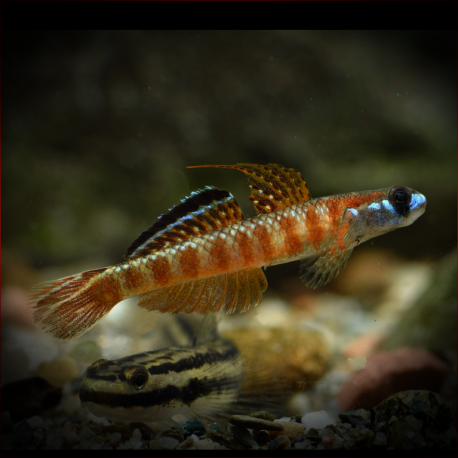More info
Datasheet
| Minimum Tank Size | 60 litres / 15.85 US gallons |
| Maximum Size | 3.5cm / 1.38inches |
| Temperature | 22°C / 71.60°F - 28°C / 82.40°F |
| Hardness | 2.02dgH / 36ppm - 12.05dgH / 215ppm |
| pH | 6.5-7.5 |
Behaviour
Stiphodon spp. can be kept in a community tank with peaceful, similarly-sized species like Tanichthys, Microdevario, and small Danio species (see table for more options). They can also coexist with various characins, small poeciliid livebearers, and freshwater shrimp. It is advisable to avoid aggressive feeders like some Schistura spp. Larger fish should be omitted, while non-predatory surface-dwelling species may be suitable in large setups. Male Stiphodon are loosely territorial, especially during breeding, and can be housed together with adequate space. Females tend to group loosely, with a recommended ratio of one male to two or more females. Males can distinguish between females of different species.
Feeding and Diet
Stiphodon spp. are specialized algal grazers, feeding on benthic algae and micro-organisms. Their diet includes sinking dried products and occasional meaty foods like bloodworms. A mature tank with ample algae-covered surfaces is essential for their long-term health. In cases where natural algae growth is insufficient, a separate container with algae-covered rocks can be maintained. These fishes have elongate guts designed for processing vegetable matter, and their diet should primarily consist of algae.
Reproduction & Dimorphism
Although courtship behavior and occasional spawning have been observed, rearing fry of Stiphodon spp. in captivity is yet to be achieved due to their complex amphidromous breeding strategy. Females can lay up to 10,000 eggs, which are tiny and attached to solid surfaces. Male Stiphodon initiate spawning rituals under rocks, guarding the eggs until hatching. Sexual dimorphism is prominent, with males displaying bright colors and distinct patterns, while females are comparatively plain.
Habitat and Distribution
Stiphodon spp. are primarily found in short coastal streams on tropical islands, mainly above waterfalls or cataracts. Their habitats are characterized by clear, well-oxygenated water and abundant biofilm. The species Stiphodon Rutilaureus is distributed southeastwards from northern Papua New Guinea throughout various island nations. Their range may extend to northern Australia, but records are ambiguous. Preferred substrate types and feeding behaviors contribute to their success in their niche environments.

